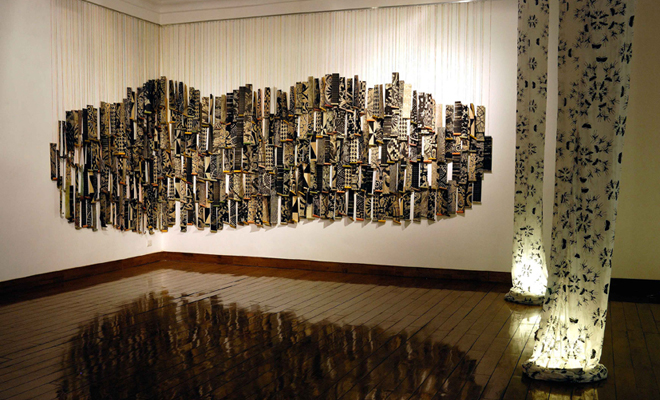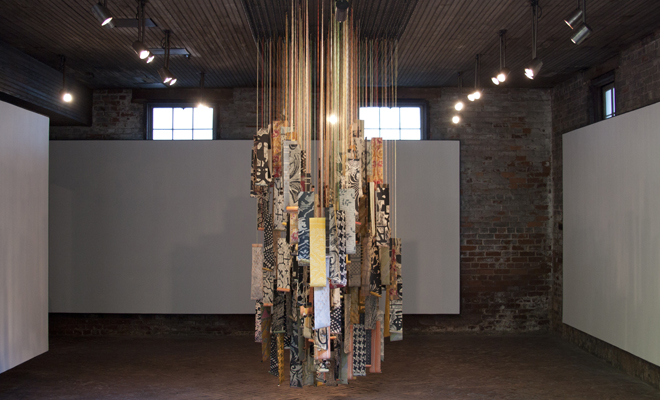Suspending Reliefs: Teresa Cole at Whitespace Gallery

Installation view of Teresa Cole's Curling In On Itself, 2010 (left), and Columns of Nuisance, 2010 (right), at Harrington Street Arts Centre, Kolkata in 2010. Courtesy the artist.
In her solo exhibition, “Between Origin and Present” at Whitespace Gallery in Atlanta, Teresa Cole appears to have given birth to something magical, some kind of other worldly creature, indefinable in rudimentary terms. The vortex of this mystical energy emanates primarily from her installation, Curling In On Itself, 2010, an accumulation of 410 hand-carved black-and-white relief prints mounted on colorful cotton and silk sari fabric. Created during a stay at the Khoj International Artists’ Residency in Kolkata, India, each individual piece literally curls up at the bottom like an ancient scroll or scraps of vintage wallpaper. A suite of framed intaglio printed collagraphs accompany this organic mass in an adjacent gallery. And though her works on paper are stunning in their own right, it is her forays into three-dimensionality that bring her work beyond the realm of the ordinary.
Her recent interest in sculptural forms may stem in part from her undergraduate studies at the Maryland Institute College of Art where she studied fiber arts (though she also earned an MFA in printmaking from Cranbrook Academy of Art) and is most certainly a result of her extensive travels throughout India to places such as Delhi, Agra, Rajasthan, and Gujarat. It is also evident that she embraces an experimental, even experiential approach to printmaking. As Professor of Printmaking at Tulane University and organizer of this year’s Southern Graphics Council International conference in New Orleans, Cole is actively engaged with a new wave of printmakers who continually challenge the status quo of this aged art form. Printing on walls and other three-dimensional surfaces, creating large-scale installations, using alternative printmaking materials, and experimenting with environmentally friendly techniques are some of the many ways printmakers such as Cole are expanding the medium. Cole is not only a professor, she is also an enthusiastic student, readily absorbing knowledge that in turn stimulates her work. While working in a printshop in Kolkata, she observed that printmakers used saris as rags to clean their plates. She later met a narrative folk painter who described the process of using old saris to back paintings, which are often rolled in a scroll format. Both encounters inspired the development of Curling In On Itself.
Exploring mediums and merging perceived dichotomies are essential components of Cole’s practice. Her body of work from the mid-1990s to the present (she relocated to New Orleans in 1994 from Tallahassee, Florida) vacillates between figuration and abstraction, organic and mechanical, traditional and unconventional, printmaking processes and fiber arts. In Cole’s description of Curling In On Itself, her vision is made abundantly clear.
The intent is to examine the malleability of sensory knowledge through layering enlarged marks and magnified views. Relationships are formed between abstraction and representation, the simple and the complex, confusion and order. The objective is a tracing of the past to hopefully understand our complicated world. The need to recover an imagery’s origins, finding similarities and differences between cultures. Searching for a source of identity through an exploration in pattern. Trying to understand ornament as a visual language and ultimately through this use of pattern exploring how cultures influence each other.

Installation view of Teresa Cole's Curling In On Itself, 2010, at Whitespace Gallery, Atlanta in 2012. Photo by Julie Sharpe. Courtesy the artist and Whitespace Gallery, Atlanta.

Detail view of Teresa Cole's Curling In On Itself, 2010, at Whitespace Gallery, Atlanta in 2012. Photo by Julie Sharpe. Courtesy the artist and Whitespace Gallery, Atlanta.
Drawing from multiple cultural references—from Islamic patterns that rely on complex mathematical equations to textiles she observed on a visit to the Calico Museum of Textiles in Ahmedabad—Curling In On Itself encourages further consideration of its formal qualities and conceptual possibilities.
For both prior presentations of Curling In On Itself—first at the Harrington Street Arts Centre in Kolkata in 2010 and later in “NOLA NOW, Part I: Swagger for a Lost Magnificence,” an exhibition I organized at the Contemporary Arts Center in New Orleans in 2011—the installation was hung flat against the wall in a corner space, suspended from a metal hanging rail via brightly colored string and paper clips. In Atlanta, it has been transformed, assuming a more imposing presence in the gallery space. Hung from a metal grid mounted on the ceiling in the center of one of Whitespace’s two galleries, Curling In On Itself can be viewed from multiple angles. It encourages the viewer to circle its perimeter, causing it to sway with even the slightest movement. The colorful and, in some cases, iridescent sari fabric is far more visible in this configuration, giving it a subtle shimmer that was absent in previous presentations. The multicolored strings also become more apparent, creating a unique pattern of their own.

Installation view of Teresa Cole's Learning to Speak, 2008, at Tchoupitoulas Studios, New Orleans in 2008. Courtesy the artist.
Cole has created a number of site-specific and three-dimensional installations in recent years. Her exhibition, “Full Circle,” at Blue Gallery in Kansas City for the International Surface Design Conference in 2009 as well as her installation Learning to Speak—first presented at Tchoupitoulas Studios in a satellite exhibition for Prospect.1 New Orleans in 2008 and the following year at Southeastern Louisiana University in Hammond—effectively blur the line between prints and textiles. The first brought together fabric and print pieces hung so they inspired obligatory dialogue (two-dimensional prints were visible through sheer textile pieces hung from the ceiling). The latter consisted of ten, double panels of hand tie-dyed cotton with embroidered letters. Lingering somewhere between various mediums, they are clearly precursors to Curling In On Itself.
It will be interesting to see how this piece evolves. Due to its flexible nature, it is influenced heavily by the environment in which it is placed. It is modular in the sense that it can be separated and recombined endlessly. With so many individual pieces that can be viewed from the front or back and that can be hung at varying heights either in the center of a gallery or leaning against a wall, Curling In On Itself as installed at Whitespace is vastly different, in terms of size and shape, than how Cole originally conceived it. The tight placement of the individual elements (thus reducing its overall scale) may inspire the creation of additional components, or perhaps it will return to the safety of a corner space. Regardless, Cole’s Curling In On Itself is an inspiring installation, successfully synthesizing the vast processes and cultures traversed in her work.
Editor's Note
“Between Origin and Present” on view through June 30 at Whitespace Gallery in Atlanta.



